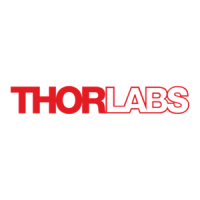Fill Factor >90%
Reflective Coating Aluminum
Average Reflectance 64% (Typical)
Phase / Retardance Range 2π at 633 nm
Angle of Incidence
a
0°
Optic Axis 45°
Reflected Wavefront Distortion <λ/2 @ 633 nm
Damage Threshold
CW
b
5 W/cm (532 nm, Ø0.0107 mm)
Pulsed (ns)
0.63 J/cm
2
(532 nm, 8.6 ns, 10 Hz, Ø203 µm)
Pulsed (fs)
0.138 J/cm
2
(535 nm, 59.4 fs, 100 Hz, Ø188 µm)
Frame Rate 30 Hz
Fluctuation / Flickering (RMS)
c
<5%
Beam Deviation Using Panel Tip / Tilt ±3.2°
Trigger Output
d
SMA Female
Trigger Output High Voltage Level 3.3 V (TTL)
Trigger Output Pulse Width 77 µs
Dimensions (L x W x H)
e
172.0 mm x 110.0 mm x 81.6 mm (6.77" x 4.33" x 3.21")
Weight 1.24 kg (2.73 lbs)
Storage Temperature 0 °C to 60 °C (32 °F to 140 °F)
Operating Temperature
f
10 °C to 40 °C (50 °F to 104 °F)
PC Connection
HDMI-Compatible Connector
USB 2.0 Connector
Bit Depth 8 Bit, 0 - 255 Gray Level
a. Other angles of incidence will result in phase shifts that differ from the programmed pattern. Angles of
up to 10° are possible without significantly affecting performance.
b. The power density of your beam should be calculated in terms of W/cm. For an explanation of why the
linear power density provides the best metric for long pulse and CW sources, please see the Damage
Thresholds tab.
c. Fluctuation / Flickering is the phase fluctuation as the percentage of the entire phase range and is
dependent on current phase setting. The value stated is the maximum fluctuation and typically occurs at
half of the phase range.
d. For more details on the external trigger output, please refer to the product manuals accessible through
the red Docs ( ) icons below.
e. The reported height dimension includes the maximum travel range of the adjuster knob.
f. Ambient temperature fluctuations may cause the characteristics of your SLM to change. Using it at an
ambient temperature of 25 °C is recommended.
DIFFRACTION EFFICIENCY
Diffraction Efficiency
When a repeating, linear phase pattern is displayed on the SLM, it will function similarly to a blazed diffraction grating. The diffraction efficiency is the power in
the first-order of the diffraction pattern divided by the zero-order when the phase of the SLM is set to zero across the panel. These measurements were made at
633 nm, 1064 nm, or 1550 nm for several test patterns with varying phase steps, effectively creating gratings with varying line spacing (denoted as line pair
/ mm). The measured results and patterns used are plotted below.

